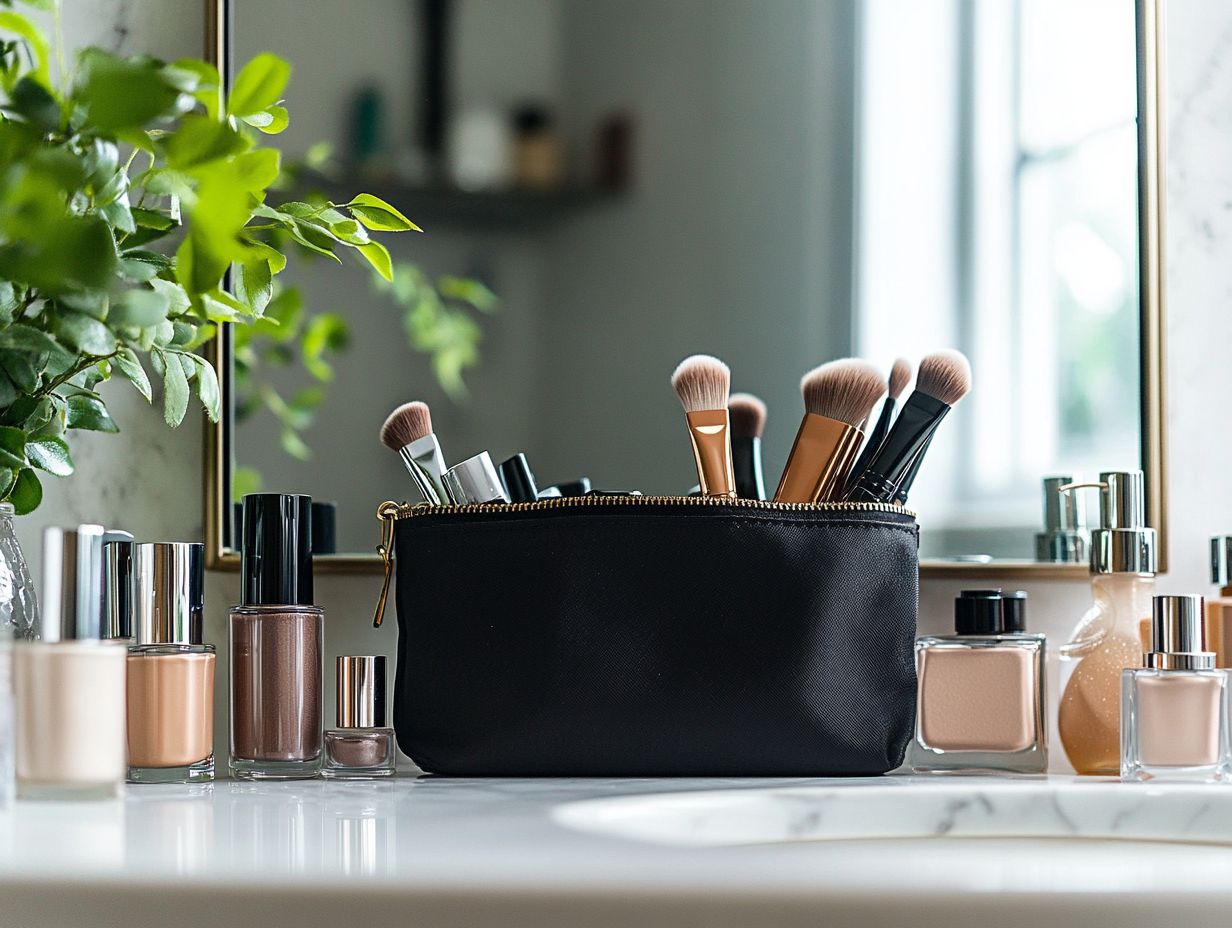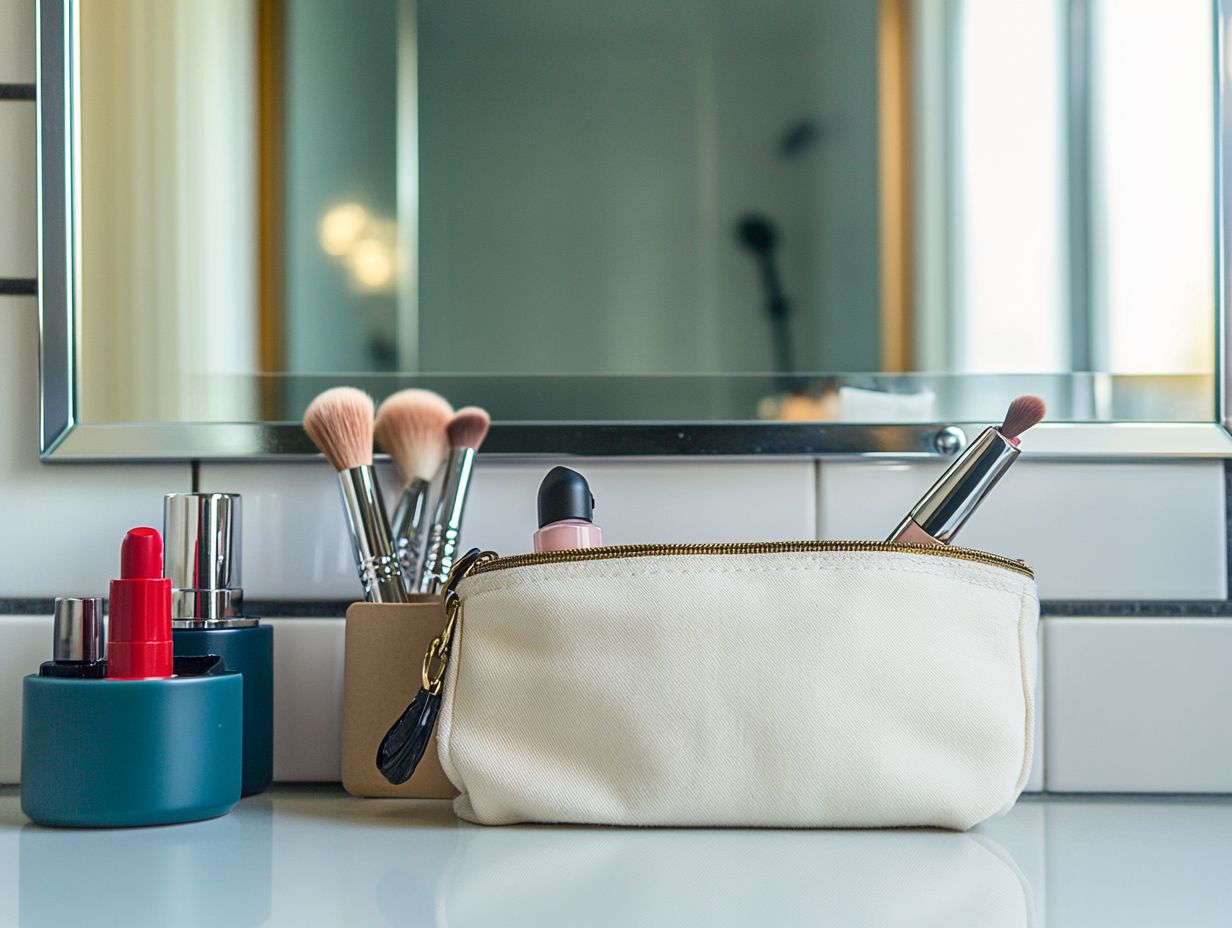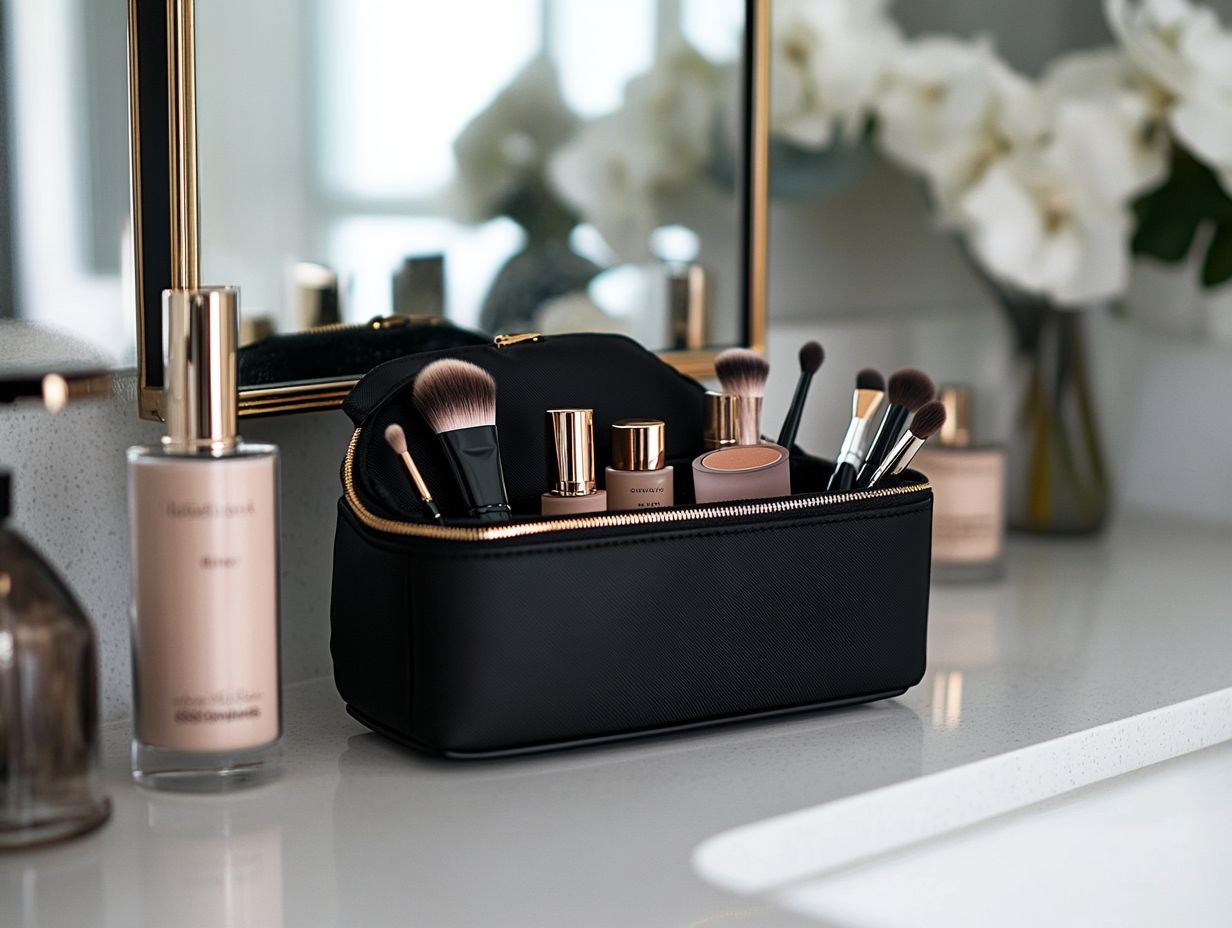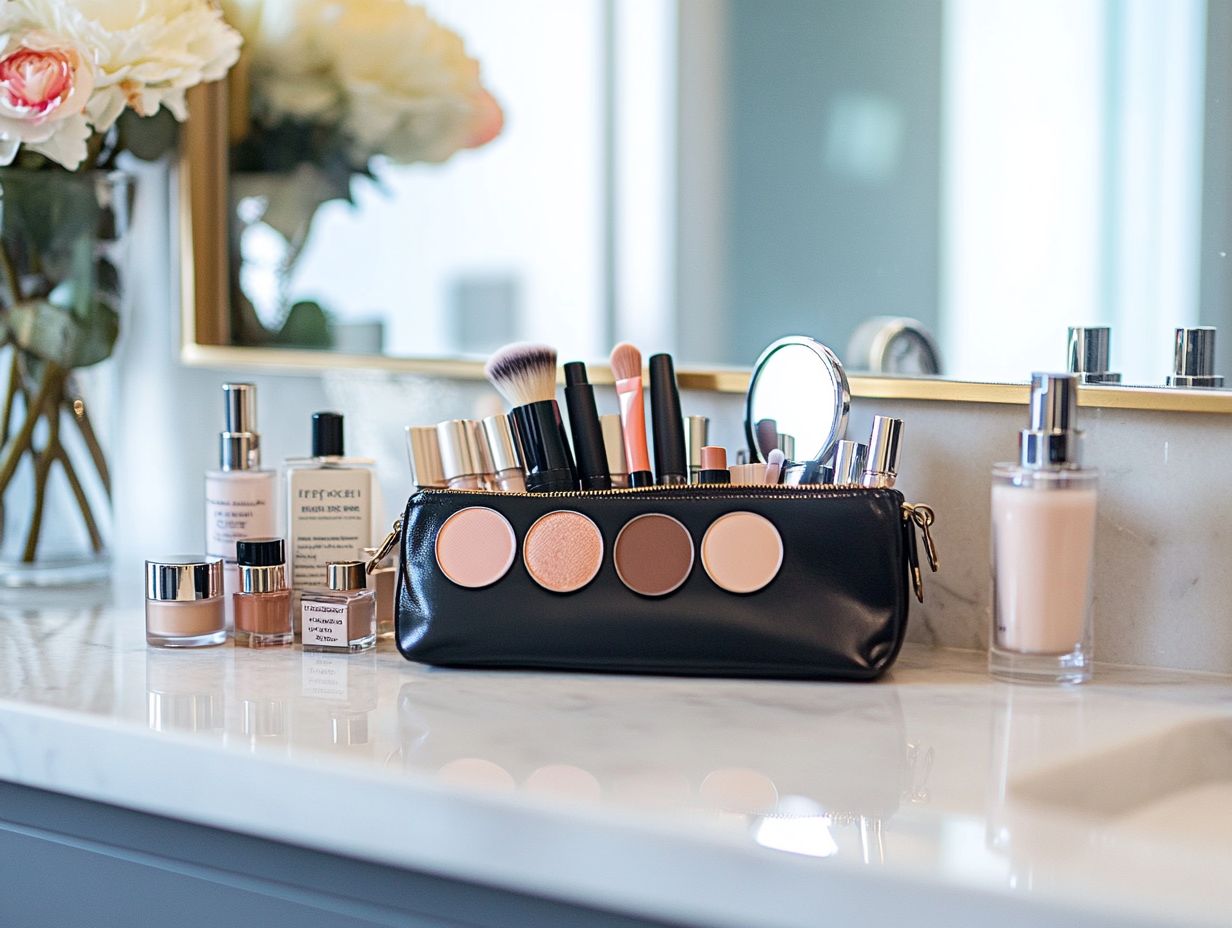Makeup is intended to enhance beauty, but there are times when things don’t quite go as planned. Whether it’s a foundation that fails to blend seamlessly or eyeliner that smudges, makeup mishaps can lead to frustration.
In this article, I will address common makeup mistakes and provide quick fixes to help regain control and confidence. From effective foundation blending techniques to correcting lipstick errors and perfecting blush placement, I will share practical tips that ensure your makeup looks flawless every time.
Key Takeaways:
Common Makeup Mishaps

Makeup is an art form that, when executed properly, enhances beauty and self-confidence. However, common makeup mistakes can result in undesirable effects, often leading to frustration among enthusiasts.
Issues such as uneven foundation application, poorly blended concealer, mismatched blush shades, and clumping mascara can significantly alter the overall look. Additionally, the importance of lighting cannot be overstated, as it dramatically influences how makeup appears.
Understanding these common pitfalls and learning how to correct them is essential for achieving a flawless and polished appearance.
Types of Makeup Mistakes
Makeup mistakes can occur at any stage of the application process, often stemming from a lack of understanding of products and techniques. I find that common errors include applying too much foundation, which can lead to an uneven and cakey appearance.
Additionally, using the wrong shade of concealer can fail to effectively cover imperfections. I have observed that blush can be misapplied, resulting in an overly harsh look, while eyeshadow mistakes can lead to clashing colors or improper blending, ultimately affecting the overall texture. Neglecting hydration is another issue, as it can cause makeup to settle into fine lines, diminishing its effectiveness.
In my experience with foundation, it’s essential to choose formulas that suit one’s skin type; for instance, opting for matte finishes on dry skin can exacerbate flakiness.
With concealers, matching not just the color but also the undertone is crucial; a yellow-toned concealer on pink-toned skin can create a disjointed look. I’ve noticed that blush application can often veer too low on the cheeks, which leads to a dated appearance. Additionally, eyeshadow mishaps, such as using a shimmer where matte is needed, can produce unwanted shine.
Understanding appropriate texture and selecting the right shades relative to natural undertones can dramatically enhance the finished look. Furthermore, maintaining a consistent skincare routine prepares the canvas for flawless makeup application.
Quick Fixes for Foundation
Achieving a flawless foundation look can be quite challenging, particularly when dealing with uneven application or mismatched shades.
Fortunately, there are several effective solutions available to address these common foundation issues. Techniques such as proper blending, applying the product in light layers, and utilizing the appropriate tools can greatly enhance the overall texture and appearance of the foundation.
Moreover, understanding how to adjust the shades of foundation with the right products and techniques is essential for ensuring that my makeup appears seamless and natural, ultimately creating the perfect canvas for the remainder of my makeup application.
Blending Techniques

Blending techniques are essential for achieving a flawless makeup application, especially when it comes to foundation and concealer. Proper blending not only creates a seamless look but also ensures that the makeup adheres well to the skin’s texture.
Techniques such as stippling, buffing, and utilizing damp makeup sponges allow for an even application without excess product weighing down the skin. Mastering these methods can significantly enhance my makeup skills and improve my overall appearance, resulting in a polished and natural finish.
Along with these techniques, the choice of tools plays a crucial role in the blending process. For instance, brushes can provide a different finish compared to sponges, often delivering more coverage when using a buffing motion.
It is vital to blend foundation and concealer into the hairline and along the jawline to avoid any harsh lines. When applying blush, I find that using a light hand and circular motions creates a youthful flush, while over-applying can yield a clown-like effect.
One common mistake to avoid is rushing the blending process; taking my time allows for a more integrated look. If any blending errors occur, I can use a clean brush to feather out any excess product, ensuring a smoother finish that appears effortlessly beautiful.
Color Correction
Color correction is an essential component of makeup that can significantly improve the application of foundation and concealer, particularly for those with uneven skin tones or specific imperfections.
By utilizing color theory, I can effectively apply corrective shades to counteract discoloration, such as redness or dark circles. This technique facilitates a smoother foundation application and helps achieve a more balanced and uniform appearance.
Mastering the proper application of color correctors before applying foundation can be transformative in attaining that sought-after flawless finish.
Incorporating complementary shades into my routine allows me to neutralize unwanted hues effectively. For example, I often use a green corrector to counteract redness, while a peach or orange shade can brighten dark circles on medium to deep skin tones.
When applying these correctors, I use a light hand with either a brush or a cosmetic sponge, gently dabbing the product onto the affected areas and blending it seamlessly into the skin.
After setting the color correctors, applying foundation over them not only covers the imperfections but also enhances the desired tone, resulting in a polished and even complexion.
Fixing Eyeliner and Mascara Mistakes
Eyeliner and mascara have the potential to significantly enhance the eyes, yet mistakes such as smudges, uneven application, and clumping can detract from a polished appearance. Understanding how to address these common issues is essential for maintaining an attractive look.
Whether it involves using a makeup remover to correct errors or reapplying products for improved definition, there are numerous effective techniques to ensure that my eye makeup remains flawless throughout the day. Mastering these solutions not only boosts my confidence but also enhances my overall satisfaction with my makeup routine.
Smudges and Smears

Smudges and smears in eyeliner and mascara can be quite frustrating, often leading to an unkempt appearance that undermines my makeup efforts. These issues frequently arise from various factors, such as insufficient drying time or having oily skin.
Rubbing my eyes or encountering humidity can exacerbate the problem, resulting in those unwelcome streaks. To address these challenges, I find it essential to invest in high-quality, waterproof products specifically designed to withstand moisture and ensure long-lasting wear.
Additionally, setting my makeup with a light dusting of translucent powder helps lock everything in place. In terms of correcting smudges, I use a cotton swab dipped in micellar water for precise touch-ups without disrupting the overall look.
By employing these strategies and selecting the right products, achieving a flawless finish becomes not only feasible but also straightforward.
Uneven Application
The uneven application of eyeliner and mascara can significantly affect the overall appearance of eye makeup, resulting in a look that lacks balance and detracts from one’s features. To achieve symmetry, it is essential to employ proper techniques and tools during application.
Whether using a fine brush for precise eyeliner application or selecting a high-quality mascara that effectively separates lashes, correcting unevenness is achievable through straightforward adjustments. Understanding my eye shape and practicing these techniques enhances the overall effectiveness of my makeup application.
Maintaining a steady hand is crucial; I find that bracing my elbow on a flat surface helps provide the necessary stability. For eyeliner, I prefer waterproof formulas, as they deliver better hold throughout the day and minimize the risk of smudging.
Utilizing eyelash curlers prior to mascara application can also open up the eyes, while layering mascara in a zigzag motion ensures that each lash is coated evenly. Techniques such as using tape for a sharper eyeliner finish or a cotton swab for touch-ups can help achieve that desired flawless look, making symmetry more attainable without excessive effort.
Solutions for Lipstick and Lip Liner Errors
I recognize that errors with lipstick and lip liner can greatly impact the overall beauty of a makeup look, often resulting in issues such as feathering, bleeding, or uneven lines that can be quite visible.
These challenges usually stem from improper application techniques or the selection of shades that do not complement the complexion. Fortunately, there are several effective solutions to address these common problems, enabling me to achieve a polished and sophisticated lip appearance.
By mastering the techniques for applying lipstick and lip liner correctly, I can ensure my lips look flawless and refined.
Feathering and Bleeding

Feathering and bleeding of lipstick and lip liner can create an untidy appearance that detracts from a polished makeup look. I have found that these issues often arise from using creamy or overly emollient formulas that lack staying power.
To address feathering and bleeding, I apply a lip liner as it provides a defined barrier that prevents lipstick from migrating beyond the lips. Additionally, using a setting powder or specific lip products designed to lock in color enhances the longevity of my lip makeup, ensuring a clean and crisp finish.
I recognize that inadequate lip prep plays a crucial role in these makeup mishaps; dry or flaky lips can exacerbate feathering. Therefore, I prioritize exfoliating and hydrating my lips before applying any lip products. I also opt for matte or long-wear formulas to minimize the risk of color running.
Selecting products that include moisture-retaining ingredients, such as hyaluronic acid, further improves the overall look.
Employing strategic application techniques, such as dabbing instead of swiping, helps me ensure an even application and reduce unwanted movement throughout the day.
Overdrawn or Uneven Lines
Overdrawn or uneven lines in lip liner and lipstick application can create an unbalanced appearance that detracts from the overall makeup aesthetic. To achieve a more defined and symmetrical lip shape, it’s important for me to understand the techniques for precise application.
By utilizing a high-quality lip liner in combination with a well-matched lipstick, I can create a harmonious look. If I find uneven lines, I can easily correct them using a small brush and concealer to reshape and refine the edges for a polished finish.
I begin by selecting a lip liner that complements the lipstick shade, ensuring a seamless blend. When applying the liner, I use short, feather-like strokes along the natural lip contour, gradually building up the color. This technique allows for better control and creates a more natural appearance.
If I make any mistakes, a pointed cotton swab dipped in makeup remover can be used to gently clean up the edges.
Opting for a slightly lighter concealer along the lip border enhances definition and contrast, making my lips appear fuller and more refined. Regularly practicing these methods give the power tos me to create stunning lip makeup that elevates my overall beauty.
Tips for Fixing Blush and Contour Problems
Blush and contour are fundamental tools for shaping the face and imparting a healthy glow; however, improper application can result in noticeable issues such as unnatural tones or incorrect placement.
By understanding how to address these challenges, I can master the art of applying blush and contour to achieve a flattering look. Effective techniques include utilizing proper blending methods, selecting colors that complement my skin tone, and ensuring placement that enhances my features.
By applying these tips, I can create depth and dimension, resulting in a beautifully contoured appearance.
Blending and Blotting Techniques
Blending and blotting techniques are essential for achieving a seamless appearance with blush and contour, ultimately enhancing the overall look of my makeup. Proper blending ensures that colors transition smoothly on the skin, while blotting helps control shine and manage excess product.
For example, I find that using a stippling brush is particularly effective for distributing product evenly, making it easier to achieve that desired diffused look. Conversely, a damp sponge works wonderfully for softening any harsh edges, resulting in a soft, airbrushed effect.
When applying blush, I concentrate on the apples of my cheeks and blend outward towards the temples. For contouring, it’s crucial to highlight the hollows of the cheeks and along the jawline to create a natural shadowing effect.
Additionally, I make it a point to gently blot any excessive oil with a tissue throughout the day to maintain a flawless finish, ensuring that my makeup remains fresh and vibrant, just as it was meant to be.
Correcting Color and Placement
Correcting color and placement in blush and contour application is essential for achieving a balanced and natural look. I often notice that individuals may apply blush too high or too low, resulting in an unnatural appearance.
To address this, it’s important to evaluate the colors of the products used and ensure they harmonize with the skin tone and other makeup elements. By adjusting placement and utilizing lighter shades for subtle definitions, I can significantly improve the overall complexion and enhance facial features.
Using complementary shades can greatly influence the final result. For example, selecting a soft peach or rose hue for blush can brighten the cheeks without overwhelming the rest of the makeup. When applying contour, I recommend choosing a shade that is only a few tones deeper than the natural skin tone to avoid harsh, stark lines.
Employing effective blending techniques, such as using a damp sponge or a soft brush, can help ensure that the blush and contour meld seamlessly into the skin, creating a cohesive and flattering appearance.


